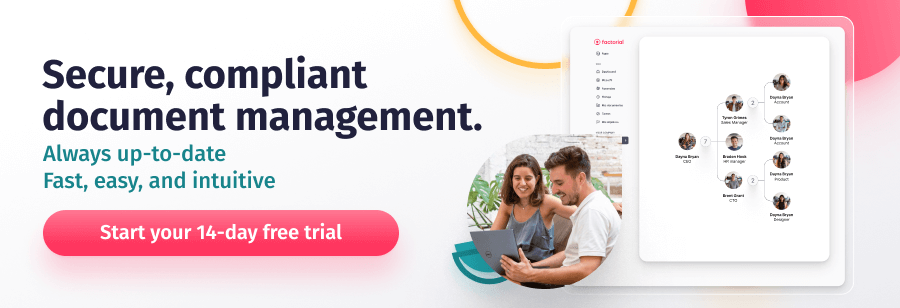A common question that many HR professionals ask themselves is “How long do employers keep employee records?”. Unfortunately, there is no simple answer to this question.
A number of factors need to be taken into consideration, including state and federal recordkeeping and reporting laws. You also need to take into account that there are different requirements for different types of personnel files.
In this post, we will break down the various types of employment records that you must retain once you terminate an individual’s employment. We will outline how long each document type needs to be stored, and which laws regulate retention at a federal and state level.
- Employee Records Retention: What Laws to Consider
- How Long Do Employers Keep Employee Records After Termination?
- Employee Record Retention by State
- Ensure Compliance with an HR Audit Checklist
- Stay on Top of Employee Records
- Stay Organized with Factorial ✅
We will also share a few tips and best practices to help you stay on top of your employee records and ensure compliance.
Employee Records Retention: What Laws to Consider
So, how long do employers keep employee records?
Generally speaking, you need to be aware of the following employment laws relating to employee recordkeeping:
- Under the Fair Labor Standards Act (FLSA), employers are required to keep payroll records for nonexempt employees for three years from the employment termination date.
- You also need to comply with recordkeeping duties defined by the Federal Insurance Contributions Act (FICA), and the Equal Pay Act (EPA).
- The U.S. Equal Employment Opportunity Commission (EEOC) requires you to maintain all employment records for one year from an employee’s termination date. The same applies to the Age Discrimination in Employment Act (ADEA).
- If an employee is involved in a dispute under the federal civil rights laws, you must keep employee files until the employer and the federal agency reach a resolution, or until the EEOC issues its decision.
- You also need to be aware of any state requirements. More on this below.
How-Long-Do-Employers-Keep-Employee-Records-After-Termination
How Long Do Employers Keep Employee Records After Termination?
So, how long do employers keep employee records, and are there different requirements for different document types?
Put simply, yes. Once you terminate an employee’s contract, you need to know how long you should retain their various records to ensure compliance with a range of federal and state laws.
Let’s take a look at the most common types of employee records and how long you should be archiving them in your employee document repository before you can safely dispose of them.
I-9 files
You need to keep a record of all employee l-9 forms and any accompanying ID documents for 3 years after hire or 1 year after separation in a secure, separate file with all employee I-9s.
Documents must be shredded after retention dates have passed.
Ensures compliance with: IRCA, INA.
Background Checks
Pre-Employment testing results and background check documents must be kept for 1 year from employment termination. This included credit checks, criminal history, driving records, consent forms, and any other forms of background checks. Documents must be shredded after retention dates have passed.
Ensures compliance with: EEOC, FCRA, TITLE VII
Employment Offers and Contracts
All employment offers and contracts must be kept for 1 year after employment termination (although your state may require that you keep records for 3 years). This includes recruitment and hiring records, job applications, resumes, advertisements about job openings, screening tools, interview notes, and records relating to hiring decisions.
Ensures compliance with: EEOC, ADEA, ADA.
Medical Records
You must retain an employee’s medical records for 3 years after termination. This includes all Family Medical Leave Records, payroll and identifying employee data, occupation, rate of pay, dates taken, hours of leave, copies of notices, documents describing benefits or policies, premium payments, and any disputes.
Ensures compliance with: FMLA.
Payroll Records
You need to keep a record of all payroll information for 3 years. This includes an employee’s name, address, social security number, gender, date of birth, occupation, job classification, daily schedules, pay rate, weekly compensation, amounts and dates of payments, daily and weekly hours, overtime hours and pay, annuity and pension payments, benefits, deductions and additions, and pay period dates. You also need to keep a written explanation of variance in pay between genders for 2 years after termination.
Ensures compliance with: FLSA, ADEA, Davis-Bacon Act, FMLA, EPA.
Employee Tax Records
You need to keep a record of all tax documentation for a period of 4 years from the date tax was due or paid. This includes your EIN, together with a record of all payments, tips, in-kind wages, personal information, undeliverable W-2s, dates of employment, PTO, income tax withholding allowance certificates, dates, and amounts of tax deposits, returns filed, and fringe benefits.
Ensures compliance with: FICA, FUTA & Internal Revenue Code.
Health & Safety Records
Finally, you need to keep a record of all health and safety records for a period of 5 years after termination. This includes job-related injury records such as logs and summaries of work-related injuries and illnesses. What’s more, if one of your employees is exposed to a toxic substance, you must keep a record of all medical exams and safety data sheets for 30 years after termination.
Ensures compliance with: OSHA.

Employee Record Retention by State
You may be wondering how long to keep employee files after termination in your state. It’s important that you check local requirements as each state has its own rules that regulate employee record retention. State laws may require you to maintain records for longer than federal regulations.
Let’s take a look at a couple of examples to highlight how requirements can change from one state to another.
How long do employers keep employee records in California?
- Payroll records and timecards should be retained for a minimum of three years after termination.
- Under the California Fair Pay Act, as amended by the Wage Equality Act of 2016, if a wage differential exists between two employees doing substantially similar work, the employer should retain any records that show a rationale for wage calculation based on seniority, merit, quality or quantity of production, or some other bona fide factor such as education, training, or experience for a period of 3 years.
How long do employers Keep records in Texas?
- You need to keep a record of payroll and tax information for 4 years.
- You also need to keep a record of certain benefits-related materials for a period of 6 years after termination.
Ensure Compliance with an HR Audit Checklist
Once you have done your research and you are aware of all recordkeeping requirements at a federal and state level, the best way to ensure HR compliance is to perform regular HR audits. While a company audit may sound like a daunting task, remember that auditing is a valuable tool that will help facilitate your business’s development.
You will need to include the following in your audit checklist:
- Decide whether you will conduct the audit internally or externally.
- Establish clear and defined objectives to result from the audit.
- Create a plan of action to arrive at your objectives.
- Collect the information and form your conclusions.
- Prepare a report with the results of the audit.
Alternatively, take a look at Factorial’s free HR audit checklist to help you plan your HR audit and stay up to date with what’s happening in your company.
Stay on Top of Employee Records
Aside from performing regular compliance audits, you also need to ensure you have an efficient system for managing all your employee records. The best solution is to use document management software. You don’t just want a system for storing documents, though. You also need to make sure you synchronize it with your payroll and time-off management software. Plus, you must have a private area for each employee in which to store contracts, withdrawals, payrolls, and ID documents.
Factorial’s all-in-one HR software solution includes features for seamlessly managing all your recordkeeping processes. That is, you can store all your employee documents in a confidential platform and access data from any device.
You also get the following benefits:
- Individual digital folders to store all employee records
- Organize your company taxes and invoices in one place
- Create workflows approvals for documents
- Configure the permissions associated with documents for your managers and employees
- Hide important documents so only authorized people can see them
- Secure data protection through a powerful encryption system and unique access per user.
Sign up now for your free trial and start improving your HR management with Factorial.




What if the employee destroyed documents and removed some as well? How do I report that